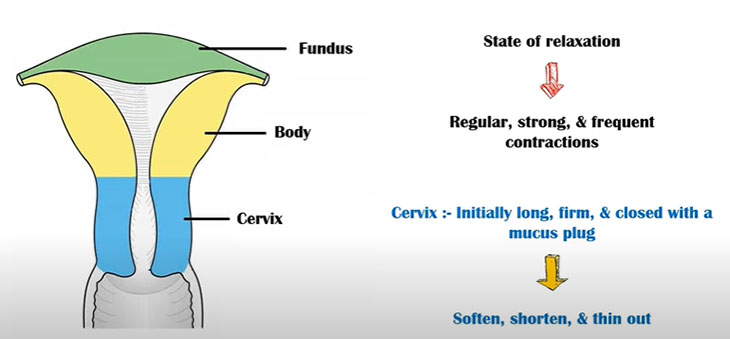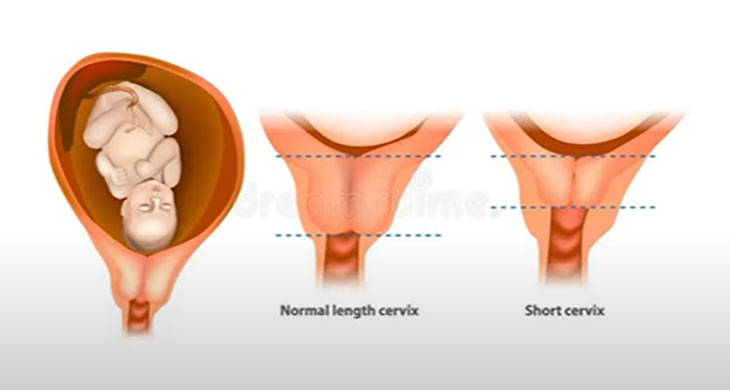The pregnancy journey culminates in one of the most significant and anticipated moments of all – labor and childbirth.
As an expectant parent, being able to recognize the signs of labor is not just empowering but essential for ensuring the safe and timely arrival of your little one.
Today, let’s see these unmistakable signals, from the subtle to the more pronounced, offering valuable insights into this remarkable phase of bringing new life into the world.
If this is your topic of interest, keep scrolling down to see every useful information the post provides!
When Does Labor Begin?

Even though due dates are usually calculated based on the average 40-week pregnancy term, it’s important to note that your baby might not arrive exactly on schedule.
Pregnancy duration can vary, with a span of 41 to 42 weeks classified as late-term, and pregnancies that extend beyond 42 weeks are termed post-term.
Conversely, labor might start before the 40-week mark, potentially occurring around week 38 or 39. Should early signs of labor 37 weeks arise, it’s considered preterm labor.
While preterm labor might halt naturally without leading to an early birth, swift medical attention is always necessary.
When your due date passes without labor beginning, the eagerness for its onset can be palpable.
Various unconventional methods, like ingesting castor oil, have been suggested to induce labor, though their efficacy lacks solid evidence.
In actuality, professionals advise against experimenting with home remedies.
Therefore, if you’re concerned about the delay in the stages of labor, the most prudent approach is to seek advice from your doctor.
What Are The Signs Of Labor?

The labor signs encompass various indicators, such as contractions, water breaking, bloody show, lightening of the baby, back pain, pelvic pressure, gastrointestinal changes, nesting instinct, cervical alterations, loss of mucus plug, and intense menstrual-like cramps.
Contractions (Intense Menstrual-Like Cramps)
How do I know labor is approaching?
Contractions are a fundamental aspect of delivery day, signifying the uterus’s effort to help the cervix dilate and facilitate the baby’s passage through the birth canal.
These muscular contractions cause the cervix to thin out and open up.
Actual labor contractions are often described as waves of tightening sensations in the lower abdomen and can extend to the lower back.
As labor progresses, contractions become more regular, stronger, and closer together.
Differentiating between false labor contractions (Braxton Hicks) and true ones is essential.
True labor contractions consistently increase in intensity and frequency, whereas false contractions tend to be irregular and less intense.
Water Breaking
What are some labor signs? The amniotic sac, also called the “bag of waters,” contains fluid surrounding and cushioning the baby throughout pregnancy.
When the amniotic sac ruptures, watery fluid is released, commonly called “water breaking.”
This can occur as a dramatic gush of fluid or a slow trickle. In addition, it might be accompanied by a noticeable pop or even a feeling similar to urinating.
Once the water breaks, it’s important to monitor the color, odor, and amount of fluid.
Clear or slightly pale fluid is typical, while green or brown fluid might indicate meconium (baby’s first stool) in the amniotic fluid, necessitating immediate medical attention.
Bloody Show
What are signs of labor? The “bloody show” is a natural and common occurrence as labor approaches.
It involves the discharge of a small amount of blood-tinged mucus from the cervix as it softens and dilates.
This results from tiny blood vessels breaking due to the cervix’s changing structure.
The mucus may appear pink, brown, or red, accompanied by mild cramping or contractions. The appearance of the bloody show is a positive sign that the cervix is preparing for delivery.
It’s usually an indicator that the dilation and effacement process has begun.
However, note that the presence of the bloody show doesn’t necessarily mean that labor will start immediately.
Some individuals may experience it days before delivery begins, while others might notice it just before real labor.
Lightening
Also known as “engagement” or “dropping,” – lightening refers to the baby’s descent into the pelvis in the weeks leading up to signs labor is coming.
As the baby’s head moves lower, it eases the pressure on the diaphragm, allowing the expectant mom to breathe more comfortably.
This can evoke a sensation of “lightening” or reduced pressure in the upper abdomen.
For first-time mothers, lightening typically occurs a few weeks before labor. However, for those who have had previous pregnancies, it might not happen until delivery is imminent.
Lightening can relieve shortness of breath, resulting in increased pelvic pressure and the feeling that the baby is “in the pelvis.”
Back Pain
Back pain is one of the typical pregnancy labor signs that can develop. This ache can be modest to severe and frequently originates in the lower back.
The lower back may experience increased pressure when the uterus contracts and the cervix starts to dilate.
Additionally, this sensation might be brought on by hormone changes, ligament relaxation, and the baby’s position.
Back pain during pregnancy might manifest as a persistent discomfort or as spasms from time to time.
It may spread to the hips and buttocks during uterine contractions and become more pronounced.
Pelvic Pressure
Pelvic pressure becomes noticeable as your child descends into the pelvis in preparation for birth. This pressure results from the baby’s head pressing against the pelvis and cervix.
While the pressure can be uncomfortable, it’s a positive sign that labor is progressing and the baby is getting into position.
Pelvic pressure might feel like a heaviness or fullness in the pelvic area.
Some individuals describe it as a feeling that the baby is “pushing down.” Furthermore, this sensation can intensify when walking, standing, or changing positions.
Diarrhea or Nausea
What are signs of early labor? As the body prepares for delivery, hormonal changes and the increasing pressure on the uterus can affect the digestive system, giving rise to signals like diarrhea or nausea.
Also, nausea or vomiting can occur before labor due to hormonal shifts and the body’s response to the impending labor.
While these gastrointestinal changes might be uncomfortable, they are considered normal symptoms that the body is getting ready for childbirth.
Staying hydrated and maintaining a balanced diet during this time is vital to support your overall well-being.
Nesting Instinct
The nesting instinct is a phenomenon where expectant parents experience a sudden burst of energy and an intense urge to prepare their living space for the baby’s arrival.
The behavior often manifests itself in the final weeks before labor. It is thought to be a primal instinct to create a comfortable, safe environment for the newborn.
Balancing this enthusiasm with rest and self-care is crucial, even if the nesting impulse can help get everything in order before the baby arrives.
Fatigue from overexertion is undesirable as labor approaches.
Cervical Changes
The cervix changes as labor draws near to prepare for childbirth. The cervix starts to swell, soften, and thin (efface).
These modifications enable the baby’s head to enter the delivery canal during labor. Cervical changes, which show that your body is preparing for coming to life, are an important stage of labor.
It’s crucial to remember that not all cervical alterations trigger labor right away. Before active delivery starts, some people may undergo progressive changes over a few days or weeks.
Loss Of Mucus Plug
The thick gelatinous mucus plug seals the cervix during pregnancy, providing a protective barrier against infections.
The cervix begins to soften, thin out, and dilate as labor approaches.
This can entail the gradual dislodging of the mucus plug, often seen as a discharge that might be streaked with blood.
The mucus plug is lost naturally and frequently, showing that the cervix changes in preparation for labor.
What To Do When You Suspect That You’re In Labor?

As labor unfolds, steps are essential to ensure a safe and smooth transition into childbirth.
Here’s a comprehensive guide to help you stay prepared and make informed decisions:
Time Your Contractions
Contractions act as important indicators of how your labor is advancing.
To keep track, begin timing the intervals between contractions using a stopwatch or a smartphone app. Moreover, record each contraction’s start and end times and the gap between them.
This strategy assists in recognizing any consistent patterns and helps you determine if your contractions are gradually becoming more uniform and occurring at shorter intervals.
Stay Hydrated and Rest
Hydration is a cornerstone of maintaining your well-being during labor.
The body’s exertions, along with the warm environment of the birthing room, can cause fluid loss through perspiration and exertion.
Consequently, staying well-hydrated is significant to counteract this fluid loss and maintain your body’s equilibrium.
While consuming large quantities of fluids might seem challenging during labor, taking small sips of water or clear liquids at regular intervals can contribute significantly to your hydration.
These regular sips can stave off dehydration and help sustain your energy levels.
In addition to hydration, the value of brief moments of rest cannot be underrated.
The intensity of contractions and the emotional engagement of the process can be physically taxing.
Therefore, these brief pauses allow your body to recover, conserve energy, and mentally prepare for the next surge of contractions.
Contact Your Healthcare Provider
Communication with your healthcare provider is essential during this phase.
If you’re unsure whether your contractions are true labor contractions or have concerns about any symptoms you’re experiencing, reach out to your healthcare provider.
They can offer advice depending on your particular circumstances, assisting you in choosing whether to go to the birthing facility or carry on laboring at home.
Inform Your Support Team
Establishing a robust support network can greatly enhance your labor experience. It’s advantageous to communicate your progress to your close ones and partner.
Your support network can provide valuable encouragement, emotional backing, and practical help tailored to your requirements.
Sharing updates about your labor journey with your partner, family, friends, or even a hired doula ensures you’re not navigating this path solo.
Their physical and emotional support can significantly impact your capacity to handle labor’s difficulties.
Whether it’s a reassuring word, a comforting touch, or a helping hand, having your support network well-informed about your progress ensures you’re surrounded by care and companionship throughout this transformative journey.
Listen to Your Body
Amidst the intricate labor journey, your body engages in a unique form of communication. Pay keen attention to the messages it conveys.
If you detect an inclination to alter your position, move with the ebb and flow, or find solace in a specific stance, embrace those instincts.
Trusting in your body’s intuitive cues allows you to uncover postures and movements that amplify your resilience in managing labor, ultimately enhancing your comfort throughout the process.
Comfort Measures
As you progress through your labor journey, practicing comfort measures plays a central role in relieving discomfort and creating a more positive environment.
Methods such as controlled breathing, visualization exercises, practicing relaxation techniques, and utilizing tools like pillows or birthing balls can significantly contribute to your sense of relief.
By delving into these various techniques, you can discover the strategies that harmonize most with your needs.
This addresses discomfort and contributes to an improved sense of overall well-being, making your labor experience more manageable and reassuring.
Go to the Hospital
You should proceed to the hospital or birthing facility when your labor develops, and your contractions become more frequent and intense.
Talk with your healthcare professional to learn the precise signs denoting the ideal moment for the baby’s arrival.
Generally, when your contractions occur approximately every five minutes and persist for about a minute, this is a notable signal that active labor has commenced.
At this point, begin your journey toward your selected birthing facility to ensure the utmost care and support for your delivery process.
Frequently Asked Questions
Is Labor Longer When Induced?
The delivery length after induction can vary widely and is influenced by multiple factors.
Induction of labor involves initiating contractions artificially when labor hasn’t started on its own or when there are medical reasons to expedite the process.
However, it’s crucial to note that the duration of labor after induction can depend on several variables:
- Cervical Ripeness: Induction might shorten the labor if the cervix is partially effaced and dilated. A less ripe cervix could result in a longer delivery.
- Medical Indication: The reason for induction plays a role. Inductions due to medical complications have different timelines than elective inductions.
- Method of Induction: The process used for induction can affect labor duration. Induction methods include medications like Pitocin, mechanical approaches to ripen the cervix, and sometimes water breaking.
- Mother’s Response: How a woman’s body responds to the induction process can influence labor length. Some may progress quickly, while others might take more time.
- Baby’s Position: The baby’s position and how well they descend into the birth canal can impact the labor duration
- Previous Pregnancies: If a woman has given birth before, her body might react differently during induction and labor.
How Long Is Labor After Induction?
Following induction, the duration of labor can exhibit a substantial range of variability.
On a typical scale, the process usually spans about 12 to 24 hours on average.
However, this timeline is profoundly contingent on multiple factors, with cervical readiness, the chosen induction method, and your body’s specific response playing pivotal roles.
The extent of cervical preparation can significantly influence the pace of labor, as a more favorable readiness may lead to a more efficient progression.
Similarly, the method employed for induction can have a marked impact on the swiftness of labor’s unfolding.
It can involve medications like Pitocin, mechanical techniques to prepare the cervix, or the breaking of the water.
Your body’s response to induction adds another layer of complexity. Ultimately, labor’s course after induction is a uniquely individual experience.
Some individuals might encounter a shorter labor period, swiftly moving towards childbirth, while others may embark on a longer journey.
It’s imperative to underscore that your medical professional will diligently monitor your advancement in pursuing the safest and healthiest outcome for you and your unborn child.
They will provide tailored guidance and recommendations that align with your distinct circumstances.
This attentive oversight ensures that your labor journey is well-supported and optimized for the best possible result.
The Bottom Line
The signs of labor act as nature’s signals, indicating that your baby is ready to make its way to the world.
From the subtle shifting of sensations to the more overt contractions, the journey of labor is an experience like no other.
By staying informed about these signs of giving birth, you are better equipped to navigate this transformative time with confidence and comfort.
As you embark on this extraordinary passage to parenthood, may these common clues guide you toward a safe and joyous childbirth experience.
